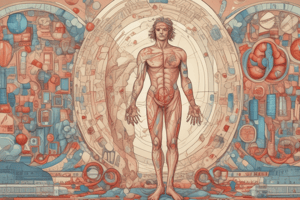Podcast
Questions and Answers
What is the Latin name for diabetes?
What is the Latin name for diabetes?
- Insulin Resistance
- Diabetes Mellitus (correct)
- Glucagon
- Hyperglycemia
What occurs in Type 1 diabetes?
What occurs in Type 1 diabetes?
- The body cannot utilize insulin efficiently
- The body produces too much insulin
- The body becomes resistant to insulin
- The body cannot produce insulin (correct)
What are the signs and symptoms of diabetes mentioned in the text?
What are the signs and symptoms of diabetes mentioned in the text?
- Increased urine output, decreased appetite, and fatigue (correct)
- Decreased urine output, increased appetite, and insomnia
- Increased urine output, increased appetite, and insomnia
- Increased thirst, increased appetite, and weight gain
How is diabetes diagnosed?
How is diabetes diagnosed?
What are the major complications of diabetes mentioned in the text?
What are the major complications of diabetes mentioned in the text?
What does Type 1 diabetes account for approximately in diabetes cases?
What does Type 1 diabetes account for approximately in diabetes cases?
What does Type 2 diabetes occur when?
What does Type 2 diabetes occur when?
What is needed to control blood glucose levels?
What is needed to control blood glucose levels?
What does the nurse need to understand to ensure the patient receives high quality care?
What does the nurse need to understand to ensure the patient receives high quality care?
How is diabetes diagnosed?
How is diabetes diagnosed?
What is the first-line drug for type 2 diabetes?
What is the first-line drug for type 2 diabetes?
Which type of insulin is a rapid-acting synthetic insulin?
Which type of insulin is a rapid-acting synthetic insulin?
What is the primary goal of insulin therapy?
What is the primary goal of insulin therapy?
Which medication delays carbohydrate digestion, affecting postprandial blood glucose?
Which medication delays carbohydrate digestion, affecting postprandial blood glucose?
Which insulin provides a basal amount of insulin, usually administered twice a day?
Which insulin provides a basal amount of insulin, usually administered twice a day?
Which insulin type is the most commonly used?
Which insulin type is the most commonly used?
Which insulin is fast-acting and used for immediate blood sugar reduction and in emergencies?
Which insulin is fast-acting and used for immediate blood sugar reduction and in emergencies?
What do sulfonylureas and meglitinides primarily promote?
What do sulfonylureas and meglitinides primarily promote?
What is the main function of biguanides like metformin?
What is the main function of biguanides like metformin?
What is crucial for achieving glycemic control and should be individualized based on diabetes type and goals?
What is crucial for achieving glycemic control and should be individualized based on diabetes type and goals?
What is Type 1 diabetes also known as?
What is Type 1 diabetes also known as?
Which of the following is a symptom of Type 1 diabetes?
Which of the following is a symptom of Type 1 diabetes?
What is a critical component in the treatment of Type 1 diabetes?
What is a critical component in the treatment of Type 1 diabetes?
What can cause hypoglycemia in individuals with Type 1 diabetes?
What can cause hypoglycemia in individuals with Type 1 diabetes?
What percentage of diabetics does Type 2 diabetes affect?
What percentage of diabetics does Type 2 diabetes affect?
Which of the following is NOT a symptom of uncontrolled Type 2 diabetes?
Which of the following is NOT a symptom of uncontrolled Type 2 diabetes?
Which oral antidiabetic drug class is used in the treatment of Type 2 diabetes?
Which oral antidiabetic drug class is used in the treatment of Type 2 diabetes?
What is essential for both Type 1 and Type 2 diabetes management?
What is essential for both Type 1 and Type 2 diabetes management?
What is a common complication of Type 1 diabetes due to insulin deficiency?
What is a common complication of Type 1 diabetes due to insulin deficiency?
Which of the following is crucial in regulating Type 2 diabetes?
Which of the following is crucial in regulating Type 2 diabetes?
Flashcards are hidden until you start studying
Study Notes
Diabetes Types and Treatment
- Type 1 diabetes, also known as juvenile diabetes, is typically diagnosed during childhood or young adulthood.
- Symptoms of type 1 diabetes include polydipsia, polyphagia, polyuria, weight loss, and fatigue due to hyperglycemia and breakdown of body fats.
- Insulin injections, diet, exercise, and blood glucose monitoring are essential in treating type 1 diabetes.
- Hypoglycemia in type 1 diabetes can result from factors such as an improper insulin regimen, dietary omission, or excessive physical activity.
- Diabetic Ketoacidosis (DKA) can occur as a complication of type 1 diabetes due to insulin deficiency, leading to symptoms such as dehydration and Kussmaul’s respiration.
- Type 2 diabetes, which is non-insulin dependent, affects approximately 85% to 90% of all diabetics and is more common in individuals over 40 and overweight.
- Symptoms of uncontrolled type 2 diabetes include polydipsia, polyuria, fatigue, blurred vision, slow-healing wounds, dry, itchy skin, and numbness in the feet.
- Treatment for type 2 diabetes involves a carefully planned diet, exercise program, oral medication, and insulin as necessary.
- Diet control, weight management, and exercise are crucial in regulating type 2 diabetes.
- Type 2 diabetes is treated with oral antidiabetic drugs, including sulfonylureas, biguanides, thiazolidinediones, and others, as well as combination therapy with certain inhibitors and blockers.
- Monitoring blood glucose levels is essential for both type 1 and type 2 diabetes management.
- Both types of diabetes require a combined effort from the physician, nurse educator, and patient for successful treatment.
Studying That Suits You
Use AI to generate personalized quizzes and flashcards to suit your learning preferences.




